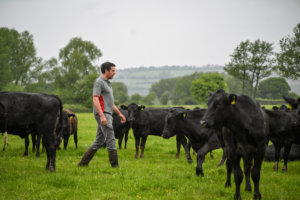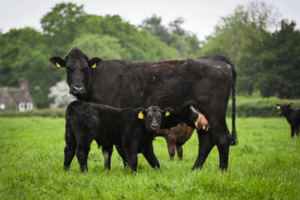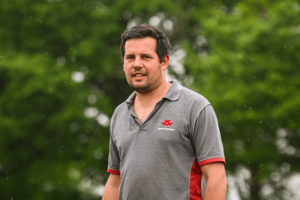Since joining his family’s farming partnership, third-generation farmer Chris Davies has significantly expanded the beef operation, with cattle numbers tripling in the past eight years.
Chris, alongside his parents Edward and Carole, manages Manor Farm in Shropshire, which now supports a herd of 120 dairy-bred suckler cows and 400 Aberdeen-Angus crossed dairy cattle finished on contract.
The farm has seen substantial changes over the past 10 to 15 years, largely driven by Chris’s involvement and his commitment to developing the cattle enterprise.
Fifteen years ago, there were no suckler cows on the farm. The system at the time was to bucket rear and finish dairy-cross beef calves, with the farm carrying around 200 cattle plus a flock of 300 Suffolk pedigree and commercial ewes.
Suckler cows were first introduced in 2010 and by 2016 they were up to around 90-head. Some of the bucket reared calves were retained for breeding, many of which were British Blue cross – a legacy which remains within the herd today.
When they first started with the suckler cow enterprise, all cows were put to Limousin bulls, but a particularly challenging night calving in 2016 prompted a change of tack.
Introduction of Aberdeen-Angus
Chris says: “We had a really difficult time calving a heifer at night and we knew we needed to do something different.
“After finishing Walford College, I spent time working in Australia and saw some huge Aberdeen-Angus herds; they operated forage based, easy management systems, and I liked the style of cattle.”
With their cattle buyer, ABP, also offering a good premium for Aberdeen-Angus sired cattle, the decision was taken to source an Aberdeen-Angus bull.
The Davies family purchased their first bull – Seafield Eric – in 2016, initially for use on heifers, and after the first crop of calves Chris and Edward immediately noticed the Aberdeen-Angus effect.
Edward says: “We saw a significant improvement in calving ease.
“This meant we had more live calves on the ground, but also because most calved unassisted, the heifers went back to the bull quickly, so we weren’t losing cows from the herd because of poor fertility.”
The impact of less calving interventions and better fertility as a result was considerable, with Edward estimating a 20% improvement in the number of live calves born and reared.
Calving ease was not the only advantage they gained, with Chris noting improved calf vigour and easier management.
“The Aberdeen-Angus calves have a lot more get up and go and compared to the Limousin sired calves, the difference in temperament is huge,” says Chris.
“The calves are also much quieter to handle, in fact they calm the Limousin calves down and it’s a bonus that you don’t need to worry about de-horning.”
Pleased with the impact of native genetics, particularly in terms of their labour-saving attributes and their ability to efficiently convert forage, the Davies family has since introduced further Aberdeen-Angus bulls into the herd, to serve both heifers and cows.
Chris explains: “Since introducing our first Aberdeen-Angus sire, we’ve purchased three more Aberdeen-Angus bulls both from Stirling and privately from the Duncanziemere herd.”
With suckler cow production margins tight, Chris says: “Our priority is a simple, efficient system that is easy to manage; Aberdeen-Angus genetics align with this and have given us the confidence to expand cow numbers.”
He adds: “The importance of calving ease can’t be underestimated, the priority has to be getting a live calf on the ground that will get up, suck and then grow well, and then the cow must get back in calf within the three-month window.”
A close eye on ration costs
Chris explains: “Generally speaking, we have a one ration for all policy to keep things simple and have been working with an independent nutritionist to keep costs low.”
When housed, all finishing cattle receive a grass based TMR comprising 50% good quality silage, alongside, fodder beet, potatoes, straw, wheat, rapemeal and urea plus bicarb and minerals, targeting growth rates of 1.4 to 1.6kg per day for steers and heifers and 2kg per day for homebred bulls.
During the winter, the cows are fed hay and supplemented with minerals.
“The TMR is currently costing £1.58 per head per day, we try and source alternative ingredients to keep costs as low as possible,” says Chris.
“Since working with our nutritionist, we’ve seen feed cost savings of around £2,500 to £3,000 per month,” adds Edward.
In late April or early May depending on the weather, all cattle will be turned out to grass. To maintain growth rates, the younger cattle will receive a small amount of cake – 1.5kg per head per day – via a snacker.
The suckler cows are paddock grazed to make optimum use of pasture with cows being moved every five days.
Chris explains: “Fields are naturally quite small and even sized, each paddock is around five to six acres, and we have five paddocks in total.”
Going forward, they plan to reseed more of the farm with herbal leys under the GS4 countryside stewardship option to produce higher volumes of good quality forage.
Ambitions for the future
Confident they have a sustainable system in place that is manageable with existing labour and leaving a decent margin, Chris has ambitions to push cattle numbers higher.
“The ambition is to increase cattle numbers to around 900,” he says.
When it comes to the suckler cows, Chris says they are looking to introduce more native genetics into the herd.
“We want slightly smaller framed cows within the herd, certainly no bigger than 650-700kg, that will milk and hold condition well from forage; native genetics fit the bill for this.”
[box out] Farm facts:
- 161ha (400 acres) of grassland, 105ha (260 acres) are owned and a further 57ha (140 acres) tenanted
- Herd of 120 commercial suckler cows, all suckler bred calves are taken through to finishing and sold deadweight
- Aberdeen-Angus bulls were introduced to the suckler herd to improve calving ease, calf management and fleshing ability of suckler-bred calves
- Suckler bred bulls are kept entire and finished at 14-15 months old and heifers at 16-18 months old targeting carcass weights of 400kg and 330-350kg respectively
- Recently started contract finishing for Blade with a current annual throughput of 400 cattle per year
- The priority is to produce high quality forage to keep ration costs to a minimum, with the farm undergoing an extensive reseeding programme with herbal leys








